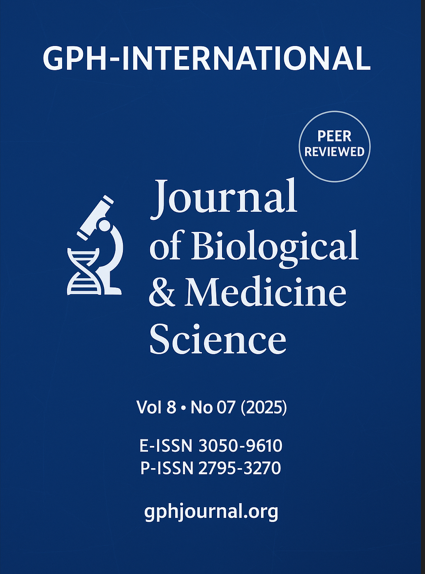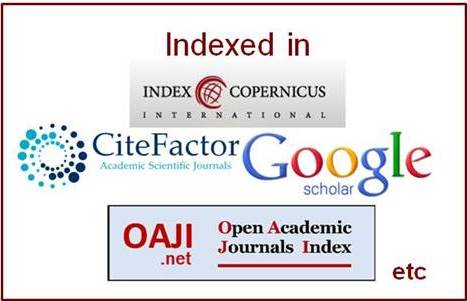Safe Termination of Pregnancy in Southwest Nigeria: A Critical Review of Legal, Policy, and Health System Challenges for Reform
Abstract
Background: Unsafe abortion contributes significantly to Nigeria’s high maternal mortality rate, estimated at over 1,000 per 100,000 live births, with Southwest Nigeria facing persistent challenges despite advanced healthcare infrastructure. Restrictive laws, policy gaps, and sociocultural stigma drive clandestine procedures, exacerbating maternal morbidity.
Objective: This narrative review critically examines legal, policy, and health system barriers to safe pregnancy termination in Southwest Nigeria, proposing reforms to enhance maternal health outcomes.
Methods: A narrative review was conducted, synthesizing data from peer-reviewed articles (1990-2025), WHO/UNFPA documents, Nigerian laws, court rulings and anecdotal reports. Thematic analysis focused on legal frameworks, policy implementation, health system capacity, and sociocultural factors, with a specific emphasis on Southwest Nigeria.
Key Findings: Nigeria’s Criminal and Penal Codes restrict abortion to life-saving cases, pushing 45% of abortions into unsafe settings (WHO, 2024). The suspended Lagos 2022 Guidelines offered progress but faced backlash. The 2025 ECOWAS Court ruling highlighted Maputo Protocol obligations, yet non-domestication stalls reform. Limited provider training, inadequate primary health center infrastructure, and stigma hinder access, particularly for adolescents. Community resistance and weak data systems further complicate reform efforts.
Conclusion: Legal reform to clarify indications, state-level guidelines aligned with WHO standards, and integration of safe abortion into reproductive health services are critical. Capacity-building, improved data collection, and community engagement with faith-based groups can reduce stigma and enhance access, positioning Southwest Nigeria as a model for national reform. With resolute political leadership, Southwest Nigeria can pioneer national reform, ensuring equitable, safe reproductive healthcare.
Downloads
References
Abortion in Nigeria | Guttmacher Institute. (2016, February 14). https://www.guttmacher.org/fact-sheet/abortion-nigeria
Abubakar, I. B., & Abubakar, H. B. (2024). Nigerian women’s modern contraceptive use: Evidence from NDHS 2018. Reproduction and Fertility, 5(2). https://raf.bioscientifica.com/view/journals/raf/5/2/RAF-23-0063.xml
Act, C. C. (1990). Laws of the Federation of Nigeria 1990. Federal Government of Nigeria: Lagos, Nigeria. https://www.jpo.go.jp/e/system/laws/gaikoku/document/index/nigeria-e_shouhyou.pdf
Akande, O. W., Adenuga, A. T., Ejidike, I. C., & Olufosoye, A. A. (2020a). Unsafe abortion practices and the law in Nigeria: Time for change. Sexual and Reproductive Health Matters, 28(1), 1758445. https://doi.org/10.1080/26410397.2020.1758445
Akande, O. W., Adenuga, A. T., Ejidike, I. C., & Olufosoye, A. A. (2020b). Unsafe abortion practices and the law in Nigeria: Time for change. Sexual and Reproductive Health Matters, 28(1), 1758445. https://doi.org/10.1080/26410397.2020.1758445
Bankole, A., Adewole, I. F., Hussain, R., Awolude, O., Singh, S., & Akinyemi, J. O. (2015). The incidence of abortion in Nigeria. International Perspectives on Sexual and Reproductive Health, 41(4), 170.
Barot, S. (2014). Implementing postabortion care programs in the developing world: Ongoing challenges. Guttmacher Policy Rev, 17(1), 22–28.
Begum, F., Zaidi, S., Fatima, P., Shamsuddin, L., Anowar‐ul‐Azim, A. K. M., & Begum, R. A. (2014). Improving manual vacuum aspiration service delivery, introducing misoprostol for cases of incomplete abortion, and strengthening postabortion contraception in Bangladesh. International Journal of Gynecology & Obstetrics, 126(S1). https://doi.org/10.1016/j.ijgo.2014.03.004
Clark, H., RamaRao, S., & Townsend, J. (2017). Ensuring Access to Safe Abortion Supplies. https://www.rhsupplies.org/uploads/tx_rhscpublications/Safe_Abortion_Supplies_Landscaping_Report.pdf
Commission, N. P. (2019). Nigeria demographic and health survey 2018. NPC, ICF. https://ngfrepository.org.ng:8443/handle/123456789/3145
Daily Post. (2024). Ogun partners CBHG to implement STOP guidelines, VAPP law. https://dailypost.ng/2024/10/25/ogun-partners-cbhg-to-implement-stop-guidelines-vapp-law/
Dzelme, K. (2024). Navigating reproductive rights: An exploration of human dignity and healthcare costs in the abortion debate. https://dspace.lu.lv/dspace/handle/7/66975
Erdman, J. N. (2023). The WHO abortion care guideline: Law and policy—Past, present, and future. International Journal of Gynecology & Obstetrics, 162(3), 1119–1124. https://doi.org/10.1002/ijgo.15017
Ganatra, B., Gerdts, C., Rossier, C., Johnson, B. R., Tunçalp, Ö., Assifi, A., Sedgh, G., Singh, S., Bankole, A., & Popinchalk, A. (2017). Global, regional, and subregional classification of abortions by safety, 2010–14: Estimates from a Bayesian hierarchical model. The Lancet, 390(10110), 2372–2381.
Geng, J. (2019). The Maputo Protocol and the reconciliation of gender and culture in Africa. In Research handbook on feminist engagement with international Law (pp. 411–429). Edward Elgar Publishing. https://www.elgaronline.com/abstract/edcoll/9781785363917/9781785363917.00034.xml
Guttmacher. (2023). Inequity in US Abortion Rights and Access: The End of Roe Is Deepening Existing Divides. https://www.guttmacher.org/2023/01/inequity-us-abortion-rights-and-access-end-roe-deepening-existing-divides
Innovation. (2023). Maternal Mortality: Osun Govt Unveils Policy Document on Safe Pregnancy Termination. https://thestandardnews.com.ng/maternal-mortality-osun-govt-unveils-policy-document-on-safe-pregnancy-termination/
Jain, D., & Balu, K. (2024). The maze of interpretation: Abortion laws and legal indeterminacy in Indian courts. Indian Law Review, 8(2), 119–141. https://doi.org/10.1080/24730580.2024.2338029
Johnson, B. R., Lavelanet, A. F., & Schlitt, S. (2018). Global Abortion Policies Database: A new approach to strengthening knowledge on laws, policies, and human rights standards. BMC International Health and Human Rights, 18(1). https://doi.org/10.1186/s12914-018-0174-2
Kanna, M. (2020). Furthering decolonization: Judicial review of colonial criminal laws. Duke LJ, 70, 411.
Klausen, S. M. (2023). Unfinished business: The feminist legal framework for abortion and ongoing struggle for reproductive justice in South Africa. In Research Handbook on International Abortion Law (pp. 61–80). Edward Elgar Publishing. https://www.elgaronline.com/edcollchap/book/9781839108150/book-part-9781839108150-11.xml
Krawutschke, R., Pastrana, T., & Schmitz, D. (2024). Conscientious objection and barriers to abortion within a specific regional context—An expert interview study. BMC Medical Ethics, 25(1). https://doi.org/10.1186/s12910-024-01007-1
Melissa, Kottke &Mimizieman. (2008). Abortion. In TeLinde’s Operative Gynaecology (10th ed., pp. 776–797).
Ministry of Health. (2018). National Guidelines on Safe Termination of Pregnancy for Legal Indications Ministry of Health, Nigeria. https://www.policyvault.africa/policy/national-guidelines-on-safe-termination-of-pregnancy-for-legal-indications/
MSF. (2023). Safe abortion care is healthcare. https://www.msf.org/safe-abortion-care-depth?utm_source=chatgpt.com
Obure, V. A., Juma, K., Athero, S., Donzo, V., Conteh-Khali, N., Ouedraogo, R., & Ushie, B. A. (2024). “Sometimes you have knowledge but lack the equipment to save a life”: Perspectives on health system barriers to post-abortion care in Liberia and Sierra Leone. Archives of Public Health, 82(1). https://doi.org/10.1186/s13690-024-01446-7
Okagbue, I. (1990). Pregnancy termination and the law in Nigeria. Studies in Family Planning, 21(4), 197–208.
Okonofua, F., Ntoimo, L., Bury, L., Bright, S., & Hoggart, L. (2024). “When you provide abortion services, you are looked upon as a bad guy”: Experiences of abortion stigma by health providers in Nigeria. Global Health Action, 17(1). https://doi.org/10.1080/16549716.2024.2401849
Okorie, P. C., & Abayomi, O. A. (2019a). Abortion laws in Nigeria: A case for reform. Annual Survey of International & Comparative Law, 23(1), 165.
Okorie, P. C., & Abayomi, O. A. (2019b). Abortion laws in Nigeria: A case for reform. Annual Survey of International & Comparative Law, 23(1), 165.
Olofinbiyi, B. A., Awoleke, J. O., Atiba, B. P., Olaogun, O. D., Olofinbiyi, R. O., & Awoleke, A. O. (2021). Predictors of Maternal Preference for Sex-Selective Pregnancy Termination in a Developing Nation with Restrictive Abortion Laws. Maternal and Child Health Journal, 25(5), 813–820. https://doi.org/10.1007/s10995-020-03062-7
Olofinbiyi, B. A., Ige, J. T., Olaogun, O. D., Alao, O. O., Adewumi, O. A., & Olofinbiyi, R. O. (2019). A stone age conduct of unsafe abortion in adolescent: Complicated by gangrenous uterus and bowel. Tropical Journal of Obstetrics and Gynaecology, 36(2), 315–318.
Olofinbiyi B.A. (2022). Adolescent reproductive health challenges: A striking area affecting the core values of future leaders’, in Leadership, policy process, and governance in the Nigerian public service (1st ed.).
Olugbolade Cole. (2023). Olofinbiyi represents Ekiti at RCOG training of champions on Safe Abortion Initiatives. Jirol. https://jiroltv.com/2023/07/19/olofinbiyi-emerges-as-representative-of-ekiti-state-at-rcogs-train-a-champion-initiative/
Oni, T. O., Adebowale, S. A., Afolabi, A. A., Akinyemi, A. I., & Banjo, O. O. (2023). Perceived health facility-related barriers and post-abortion care-seeking intention among women of reproductive age in Osun state, Nigeria. BMC Women’s Health, 23(1). https://doi.org/10.1186/s12905-023-02464-3
Orjingene, O., & Morgan, J. (2020). Effectiveness of community based interventions in reducing maternal mortality in sub-Saharan Africa: A systematic review. International Journal of TROPICAL DISEASE & Health (IJTDH), 41(9), 9–21.
PRB. (2025). Strengthening Evidence-Based Policy to Expand Access to Safe Abortion (SAFE ENGAGE). https://www.prb.org/projects/strengthening-evidence-based-policy-to-expand-access-to-safe-abortion-safe-engage/
RCOG. (2020). Our Making Abortion Safe programme. https://www.rcog.org.uk/about-us/global-network/centre-for-womens-global-health/contraception-and-abortion/our-making-abortion-safe-programme/
Rights, C. for R. (2020). The world’s abortion laws.
Sagar, K., Rego, E., Malhotra, R., Lacue, A., & Brandi, K. M. (2023). Abortion providers in the United States: Expanding beyond obstetrics and gynecology. AJOG Global Reports, 3(2), 100186.
Turk, J., Landy, U., Preskill, F., Adler, A., & Steinauer, J. (2021). The integration of abortion into obstetrician-gynecologists’ practice after comprehensive family planning resident training. Contraception, 104(4), 337–343.
Vanguard. (2022a). Lagos releases guidelines on abortion. https://www.vanguardngr.com/2022/06/lasg-releases-guidelines-on-abortion/
Vanguard. (2022b). Lagos suspends guidelines on safe, lawful abortion. https://www.vanguardngr.com/2022/07/lagos-suspends-guidelines-on-safe-lawful-abortion/
Vanguard. (2024). Safe abortions in Lagos: Stalemate or stepping stones? https://www.vanguardngr.com/2024/07/safe-abortions-in-lagos-stalemate-or-stepping-stones/
WHARC. (2000). Abortion Law in Nigeria: The way Forward. WHARC.
WHO. (2022). Abortion care guideline. https://www.who.int/publications/i/item/9789240039483
WHO. (2024). Abortion. https://www.who.int/news-room/fact-sheets/detail/abortion
Wiebe, E. R., Campbell, M., Ramasamy, H., & Kelly, M. (2020). Comparing telemedicine to in-clinic medication abortions induced with mifepristone and misoprostol. Contraception: X, 2, 100023.
Zhou, J., Blaylock, R., & Harris, M. (2020). Systematic review of early abortion services in low- and middle-income country primary care: Potential for reverse innovation and application in the UK context. Globalization and Health, 16(1). https://doi.org/10.1186/s12992-020-00613-z
Zulu, J. M., Goicolea, I., Kinsman, J., Sandøy, I. F., Blystad, A., Mulubwa, C., Makasa, M. C., Michelo, C., Musonda, P., & Hurtig, A.-K. (2018). Community based interventions for strengthening adolescent sexual reproductive health and rights: How can they be integrated and sustained? A realist evaluation protocol from Zambia. Reproductive Health, 15(1). https://doi.org/10.1186/s12978-018-0590-8
Author(s) and co-author(s) jointly and severally represent and warrant that the Article is original with the author(s) and does not infringe any copyright or violate any other right of any third parties, and that the Article has not been published elsewhere. Author(s) agree to the terms that the GPH Journal will have the full right to remove the published article on any misconduct found in the published article.























